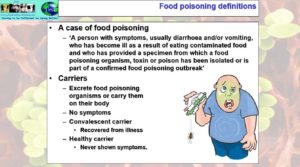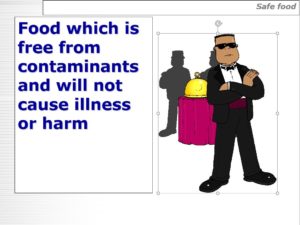Major incidents of foodborne illness
Aberdeen – Typhoid
1964 – Associated with cans of corned beef cooled in sewerage polluted water
Stanley Royd – Salmonella
1984 – Involving cross-contamination of cooling roast beef from raw chicken
resulting in 450 cases and 19 deaths
Cumbria – Salmonella Ealing
1985 – Dried baby milk (Farley Health Products) resulting in 60 cases and 1 death.
Caused by pinhole in silo allowing moisture to provide suitable multiplication
conditions. Factory value reduced from £40 million to £18 million
Wishaw – E. coli O157
1996 – Cooked cold meats and cooked steak/gravy (John Barr).
Mainly cross-contamination, resulting in 500+ cases and 21deaths.
(At least 3 major outbreaks and sporadic cases)
Birmingham – Clostridium botulinum
1989 – Hazelnut yogurt resulting in 27 cases and 1 death.
Caused by failure to undertake a risk assessment when producing new product.
(Sweetener instead of sugar (aw) and hazelnut
> pH than fruit – failure to increase processing temperature).
France – Listeria monocytogenes
1992 – Pork tongue in aspic resulting in 279 cases, 63 deaths and 22 abortions
USA – Salmonella
Pasteurised milk resulting in 18,000 cases and 2 deaths
Lawsuits in USA resulting from E. coli O157 outbreaks
June 2000 – Iwan’s Deli and catering of Orland Park
1,200 ill (potato salad) – $3,000,000
May 1998 – Odwalla Inc
5 children (apple juice) – $1,200,000
February 1998 – Jack in the Box restaurant chain
4 customers died,many more ill
Accepted $58,500,000 from 9 beef suppliers (hamburgers)
February 2001 – Taco hamburgers served with school lunch
11 children, 3 developed kidney problems (one serious).
Court awarded $4,750,000
 A case of food poisoning
A case of food poisoning
A person with symptoms usually diarrhoea and/or vomiting, who has become ill as a result of eating contaminated food and who has provided a specimen from which a food poisoning organism, toxin or poison has been isolated or is part of a confirmed food poisoning outbreak.
An outbreak of food poisoning
An incident in which two or more people,thought to have a common exposure,experience a similar illness.
Carrier/s
A person who harbours, and may transmit, pathogenic organisms without showing signs of illness.
Causative agent
The bacteria, toxin or poison that contaminates the food and causes the illness.
Contamination
The presence or introduction of a hazard. (EC Regulation No. 852/2004)
Convalescent carrier
Recovered from illness but is still excreting the organism.
Cross-contamination
The transfer of bacteria from contaminated food (usually raw) to ready-to-eat foods by direct contact, drip or indirect contact using a vehicle
such as the hands or a cloth.
Danger zone of bacteriological growth
The temperature range within which the multiplication of most pathogenic bacteria is possible i.e. 5ºC to 63ºC. Most rapid growth takes
place between 20ºC and 50ºC.
Food hygiene
All measures and conditions necessary to control hazards and to ensure fitness for human consumption of a foodstuff taking into account its
intended use. (EC Regulation No. 852/2004)
Food hygiene (cont) –
It includes:
• Rejecting contaminated, or poisonous food or food from suspect sources
• Protecting food from contamination, including harmful micro-organisms, poisons, allergens and foreign bodies
• Preventing multiplication of bacteria to a level which would result in illness of consumers or the early spoilage of food
• Destroying micro-organisms in the food or food environment
• Discarding/removing unsafe/unfit or contaminated food
Food poisoning
An acute illness, usually with symptoms of diarrhoea and/or vomiting, nausea and abdominal pain, caused by the consumption of contaminated or poisonous food (a multiplication of bacteria usually occurs within the food).
Food vehicle
The food consumed that contained the causative agent.
Healthy carrier
Never shown symptoms but is excreting organisms.
Incubation (onset) period
Time between consuming the contaminated food and showing the first signs of illness.
Pathogen
Disease-producing organism.

Risk groups


